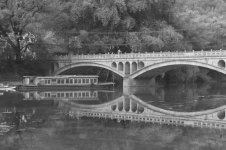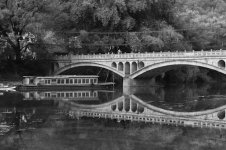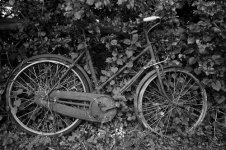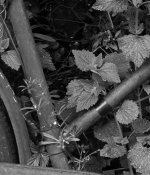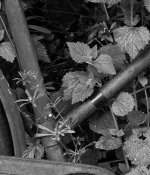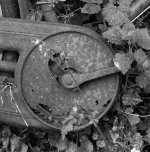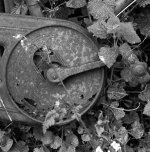I've just done some messing around with the bicycle files knocking around comparing the M9 and MM and here are my conclusions based on a desire to get 'good looking files I like' out of them both. I was using LR3.
It is clear that Leicas claim that the MM has greater green sensitivity is true. The foliage was quite a challenge.
Getting the right tonal separation to be pleasing to a silver gelatin lover was much harder with the MM, but when I finally got there, I was marginally happier with the MM than with the M9 file (just). But boy, it was harder. I generally had to pull the highlights in, use a pretty strong S curve to get some real mid tone guts into the image, with the toe and shoulder keeping things in check elsewhere in the scale... mess with contrast much more than I would normally etc etc
With the right curve to introduce mid tone contrast, which appeared entirely lacking in the original MM file, the resolution advantage stood out very clearly. This won't be obvious in an A3 print, sure, but if you are going to make a 40 or 60" print for exhibition, I think the difference will be obvious for anyone who cares. If the scene contains fine details, such as tiny distant buildings, or foliage, the MM will have a clear and visible advantage. The same goes for the more subtle tonal transitions in the MM. I'm used to silver prints and I take for granted the insane greyscale and subtle transitions. The MM is a solid leap from the M9 file in this regard.
I can't say I like the look of the straight files knocking around on the web. In short, they are pretty awful, but in all cases where I have been able to download a DNG, I have been able to make a huge improvement and arrive at files I think are OK fairly quickly. Not as quickly as a colour file, though.
I will be most interested to see how the files look when not shoot on a technically perfect high contrast lens, but on those with lower contrast.
I am not convinced by the MM in the look department... and I was nearly horrified when I opened the files initially in LR3.... but I see some serious potential here, especially if you are prepared to use colour filters (I am).
FWIW that the MM produces images that are like Acros is not good IMO. Unless shooting architecture or shiny stuff, I can't stand films like Acros and were they the only ones available, I would have stopped wet printing five years ago! I think the notion that the MM will produce great B&W files right out the camera is completely the wrong message. it should be that it will 'perhaps' produce the best files you have ever seen out of a FF camera, but you have better be prepared to work for it 🙂
In summary, I would say this about the tonal transitions:
The MM transitions are to the M9's what 5x4" is to 6x7cmi.e. a 'format leap, but at the upper end'. It is not the quantum leap you get when going from 35mm TriX to MF.
To my eye, it makes the images look more natural and better photographic depictions of reality. The converted M9 files still have that 'more digital' look i.e. where the MM files give you a sense of 'the scene', the M9 files are give you 'a picture of the scene'.
Since I started this post, I went back and completely reworked the M9 file and I still cannot get it as good as the MM. I got closer, but the sense of natural sharpness/resolution deficit is still there and the tonal richness of the MM really shines. No amount of sharpening can bring the same sense of detail the MM possesses in areas where tiny weeny details exist, but you can get close elsewhere. The end result id that the MM files still seem to have a bit more sparkle and 'naturalness'.
My conclusion after admittedly only messing with these files in LR3 for an hour and a half is that if you are a home printer and make A3+ prints, I cannot imagine the MM will be worth it. In fact, it might be a bad idea because you will have less flexibility and more work to do. If you make very large B&W prints and work only in this medium, it might well be worth it. I'll have to make real prints to be sure (but currently stuck in Kabul).
My second concluson (!!) is that if you like heavily processed images, with added grain, heavily reworked tonal scale etc (i.e. Jacob Sobol look) the MM is a complete waste of time because you are throwing away all the things which (just) set it apart.


